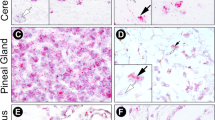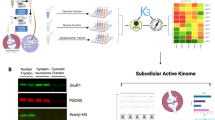Abstract
THE pioneering investigations of Sutherland and his co-workers have focused considerable attention on adenosine 3′,5′-phosphate (cyclic AMP) and its relation to cellular metabolism. Cyclic AMP is synthesized by adenyl cyclase1 and destroyed by cyclic 3′,5′-nucleotide phosphodiesterase2. Brain cortex is of special interest in that it exhibits the highest activity in both cyclase3 and phosphodiesterase activities4, with phosphodiesterase present in overwhelming excess. We have evidence suggesting that phosphodiesterase in vivo might exist in a greatly inhibited state.5 Using the subcellular fractionation technique of De Robertis et al.6,7, we find that the enzyme is partly soluble and partly particulate, with a considerable portion concentrated inside nerve endings, and that ‘Triton X–100’ revealed substantial latent activity in a microsomal fraction.
This is a preview of subscription content, access via your institution
Access options
Subscribe to this journal
Receive 51 print issues and online access
$199.00 per year
only $3.90 per issue
Buy this article
- Purchase on Springer Link
- Instant access to full article PDF
Prices may be subject to local taxes which are calculated during checkout
Similar content being viewed by others
References
Rall, T. W., and Sutherland, E. W., J. Biol. Chem., 237, 1228 (1962).
Sutherland, E. W., and Rall, T. W., J. Biol. Chem., 232, 1077 (1958).
Sutherland, E. W., Rall, T. W., and Menon, T., J. Biol. Chem., 237, 1220 (1962).
Butcher, R. W., and Sutherland, E. W., J. Biol. Chem., 237, 1244 (1962).
Cheung, W. Y., Biochem. Biophys. Res. Commun., 23, 214 (1966).
De Robertis, E., Pellegrino de Iraldi, A., Rodriguez de Lores Arnaiz, G., and Salganicoff, L., J. Neurochem., 9, 23 (1962).
De Robertis, E., Salganicoff, L., Zieher, L. M., Rodriguez de Lores Arnaiz, G., J. Neurochem., 10, 255 (1963).
Fiske, C. H., and Subbarow, Y., J. Biol. Chem., 66, 375 (1925).
Lowry, O. H., and Lopez, J. A., J. Biol. Chem., 162, 421 (1946).
De Robertis, E., in Histophysiology of Synapses and Neurosection, 122 (Pergamon Press, New York, 1964).
Salganicoff, L., and De Robertis, E., J. Neurochem., 12, 287 (1965).
Sellinger, O. Z., Rucker, D. L., and De Balbian Verster, J. Neurochem., 11, 271 (1964).
Toschi, G., Exp. Cell Res., 16, 232 (1959).
Drummond, G. I., and Perrott-Yee, S., J. Biol. Chem., 236, 1126 (1961).
Nair, K. G., Biochemistry, 5, 150 (1965).
Author information
Authors and Affiliations
Rights and permissions
About this article
Cite this article
CHEUNG, W., SALGANICOFF, L. Cyclic 3′,5′-Nucleotide Phosphodiesterase: Localization and Latent Activity in Rat Brain. Nature 214, 90–91 (1967). https://doi.org/10.1038/214090a0
Issue Date:
DOI: https://doi.org/10.1038/214090a0
This article is cited by
-
Dopamine receptors in canine caudate nucleus
Molecular and Cellular Biochemistry (1982)
-
Electron-microscopic cytochemical study of cyclic nucleotide phosphodiesterase in rat brain
Histochemistry (1978)
-
Possible regulation of membrane-associated cyclic AMP phosphodiesterase in rat cerebral cortex by lipids
Experientia (1978)
-
Proteins of the synaptic membrane
Neurochemical Research (1977)
-
Possible role for cyclic nucleotides and phosphorylated membrane proteins in postsynaptic actions of neurotransmitters†
Nature (1976)
Comments
By submitting a comment you agree to abide by our Terms and Community Guidelines. If you find something abusive or that does not comply with our terms or guidelines please flag it as inappropriate.



